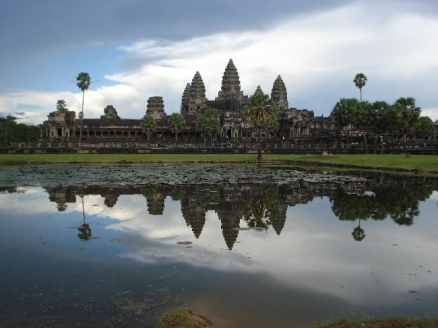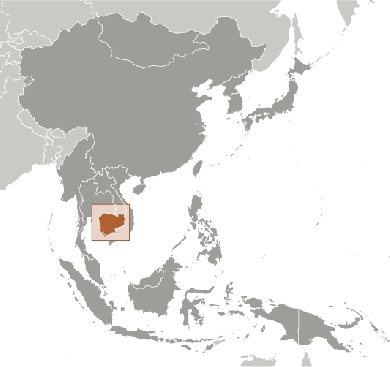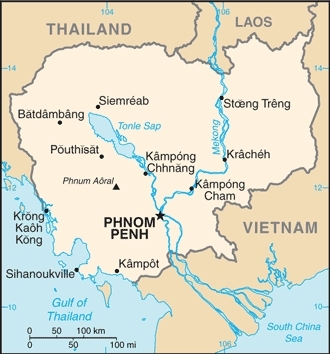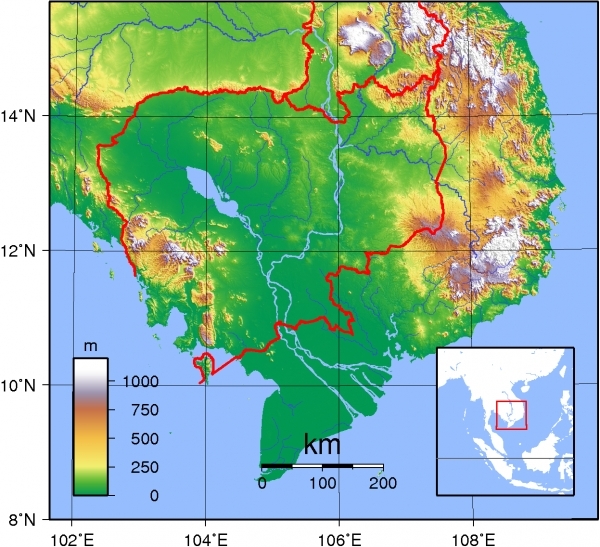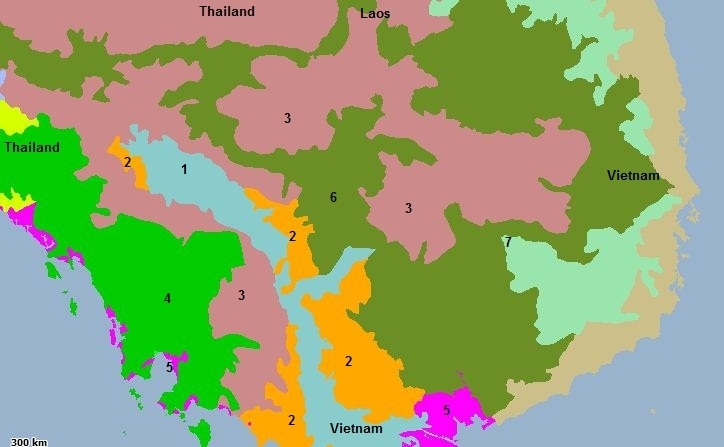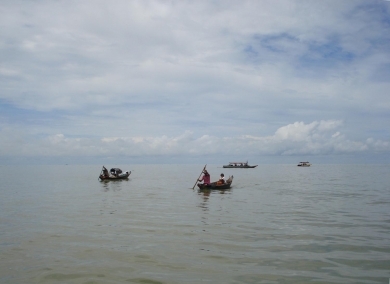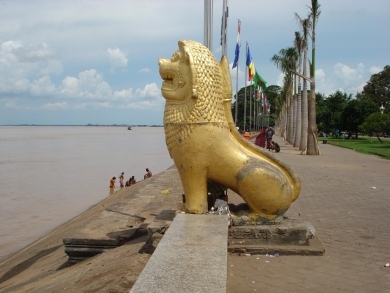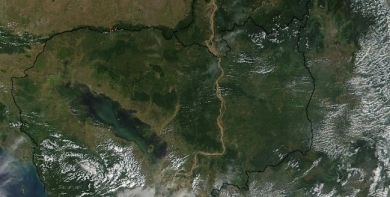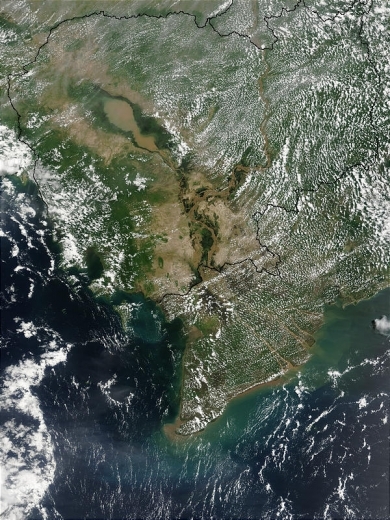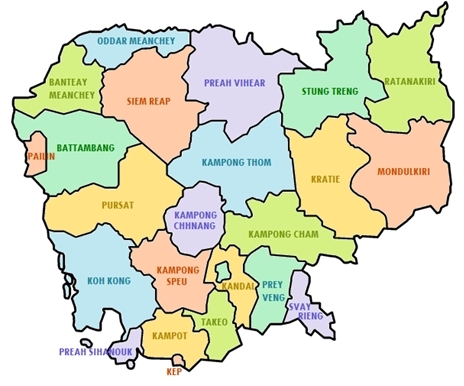Cambodia
Countries and Regions of the World Collection  Cambodia is a nation of nearly fifteen million people in southeastern Asia, bordering the Gulf of Thailand, between Thailand, Vietnam, and Laos.
Cambodia is a nation of nearly fifteen million people in southeastern Asia, bordering the Gulf of Thailand, between Thailand, Vietnam, and Laos.
Cambodia is a a land of paddies and forests dominated by the Mekong River and Tonle Sap (Cambodia's huge freshwater lake).
Its major environmental issues include:
- illegal logging activities throughout the country and strip mining for gems in the western region along the border with Thailand which have resulted in habitat loss and declining biodiversity (in particular, destruction of mangrove swamps threatens natural fisheries);
- soil erosion;
- in rural areas, most of the population does not have access to potable water; and,
- declining fish stocks because of illegal fishing and overfishing
Cambodia is susceptible to monsoonal rains (June to November); flooding;and, occasional droughts.
Most Cambodians consider themselves to be Khmers, descendants of the Angkor Empire that extended over much of Southeast Asia and reached its zenith between the 10th and 13th centuries. Attacks by the Thai and Cham (from present-day Vietnam) weakened the empire, ushering in a long period of decline.
The king placed the country under French protection in 1863 and it became part of French Indochina in 1887. Following Japanese occupation in World War II, Cambodia gained full independence from France in 1953.
In April 1975, after a five-year struggle, Communist Khmer Rouge forces captured Phnom Penh and evacuated all cities and towns. At least 1.5 million Cambodians died from execution, forced hardships, or starvation during the Khmer Rouge regime under Pol Pot. A December 1978 Vietnamese invasion drove the Khmer Rouge into the countryside, began a 10-year Vietnamese occupation, and touched off almost 13 years of civil war.
The 1991 Paris Peace Accords mandated democratic elections and a ceasefire, which was not fully respected by the Khmer Rouge. UN-sponsored elections in 1993 helped restore some semblance of normalcy under a coalition government. Factional fighting in 1997 ended the first coalition government, but a second round of national elections in 1998 led to the formation of another coalition government and renewed political stability.
The remaining elements of the Khmer Rouge surrendered in early 1999. Some of the surviving Khmer Rouge leaders have been tried or are awaiting trial for crimes against humanity by a hybrid UN-Cambodian tribunal supported by international assistance.
Elections in July 2003 were relatively peaceful, but it took one year of negotiations between contending political parties before a coalition government was formed. In October 2004, King Norodom Sihanouk abdicated the throne and his son, Prince Norodom Sihamoni, was selected to succeed him.
Local elections were held in Cambodia in April 2007, with little of the pre-election violence that preceded prior elections. National elections in July 2008 were relatively peaceful.
Cambodia has a number of international disputes:
- Cambodia is concerned about Laos' extensive upstream dam construction;
- Cambodia and Thailand dispute sections of boundary; in 2011 Thailand and Cambodia resorted to arms in the dispute over the location of the boundary on the precipice surmounted by Preah Vihear temple ruins, awarded to Cambodia by ICJ decision in 1962 and part of a planned UN World Heritage site;
- Cambodia accuses Vietnam of a wide variety of illicit cross-border activities; Progress on a joint development area with Vietnam is hampered by an unresolved dispute over sovereignty of offshore islands
Contents
Geography
Cambodia is located on mainland Southeast Asia between Thailand to the west and north and Vietnam to the east and southeast. It shares a land border with Laos in the northeast. Cambodia has a sea coast on the Gulf of Thailand. The Dangrek mountain range in the north and Cardamom Mountains in the southwest form natural boundaries. Principal physical features include the Tonle Sap lake and the Mekong and Bassac Rivers. Cambodia remains one of the most heavily forested countries in the region, although deforestation continues at an alarming rate.
Location: Southeastern Asia, bordering the Gulf of Thailand, between Thailand, Vietnam, and Laos
Geographic Coordinates: 13 00 N, 105 00 E
Area: 181,035 sq km (land: 176,515 sq km; water: 4,520 sq km)
Land Boundaries: 2,572 km (Laos 541 km, Thailand 803 km, Vietnam 1,228 km)
Coastline: 443 km
Maritime Claims:
territorial sea: 12 nm
contiguous zone: 24 nm
exclusive economic zone: 200 nm
continental shelf: 200 nm
Natural Hazards: monsoonal rains (June to November); flooding; occasional droughts
Terrain: mostly low, flat plains; mountains in southwest and north. The highest point is Phnum Aoral (1,810 m) and the lowest point is the Gulf of Thailand (0 m).
Climate: tropical; rainy, monsoon season (May to November); dry season (December to April); little seasonal temperature variation
Topography of Cambodia. Source:Sadalmelik/Wikipedia.
Ecology and Biodiversity
Ecoregions of Cambodia. Source: World Wildlife Fund
- Tonle Sap freshwater swamp forests - The swamp shrublands and forest of the Tonle Sap Freshwater Swamp Forests ecoregion include two forest associations that have been described for the extensive floodplain area of Tonle Sap, a short tree shrubland covering the majority of the area and a stunted swamp forest around the lake itself. Similar swamp forests are also present along floodplains of the Mekong and other major rivers in Cambodia. Although most of the ecoregion, including the lake, was declared a protected area recently, it was too little too late. The protected area is a paper park with no protection or management, and it was declared protected after most of the habitat had been cleared for agriculture. This is prime rice-growing habitat.
- Tonle Sap-Mekong peat swamp forests - extend over areas permanently inundated with shallow freshwater, although the region as mapped includes mosaics of swamp forest and herbaceous wetland interposed with upland areas of dry forest. However, care must be given in separating permanently flooded swamp forests of southeast Asia from seasonal swamp forests that characterize extensive areas of the Tonle Sap Basin and the floodplain of major Cambodian rivers. The Tonle Sap-Mekong Peat Swamp Forests are only a small vestige of their former range and function. More than 90 percent of this ecoregion has been converted to scrub or degraded forests. Intensive agriculture and the alteration of the hydrodynamics of the river systems in the region have altered the natural river fluctuations, adversely affecting the remaining native vegetation.
- Central Indochina dry forests - covers most of central Indochina and harbors an outstanding assemblage of threatened large vertebrates that characterize the mammal fauna of the Indo-Pacific region. Just half a century ago large populations of megaherbivores such as Asian elephants, banteng, kouprey, gaur, wild water buffalo, and Eld's deer roamed and grazed in these dry woodlands. Where human densities were still low, the landscapes were dominated by large herds of wildlife reminiscent of the savannas of east Africa. Large carnivores such as tigers, Clouded Leopards, leopards, and packs of wild dogs hunted these herbivores. Unfortunately, throughout the ensuing years habitat loss and hunting for trade have exacted a devastating toll on these species. Some species have even become extinct. The two rhinoceros species, the Javan and the Sumatran are now extinct in this ecoregion, as is Schomburgk's deer. The kouprey probably is globally extinct, although intermittent reports from remote areas of northern and eastern Cambodia keep hopes alive. Among the other species, the tiger, Asian elephant, Eld's deer, banteng, and gaur are endangered.
- Cardamom Mountains rain forests - sit astride the Cardamom Mountains (locally known as Kravanh) and the Elephant Range (locally known as Dom rei) in southwestern Cambodia and extends slightly across the border into southeastern Thailand. It is separated from the nearest other rain forest by the vast, dry Khorat Plateau in central Thailand to the north and east and by the Gulf of Thailand in the west. The Cardamom Mountain rain forests are considered by some to be one of the most species-rich and intact natural [[habitat]s] in the region, but they are also one of the least explored.
- Indochina mangroves - Among the most diverse and extensive mangrove ecosystems in the world, this ecoregion provides extremely important habitat for some of the world's rarest waterbirds. The largest block of Indochina Mangroves in the Mekong River delta suffered large-scale habitat loss from defoliants sprayed during the Vietnam War.
- Southeastern Indochina dry evergreen forests are globally outstanding for the large vertebrate fauna it harbors within large intact landscapes. Among the impressive large vertebrates are the Indo-Pacific region's largest herbivore, the Asian elephant (Elephas maximus), and largest carnivore, the tiger (Panthera tigris). The list includes the second known population of the critically endangered Javan rhinoceros (Rhinoceros sondaicus)-comprising a handful of animals in Vietnam's Cat Loc reserve-Eld's deer (Cervus eldi), banteng (Bos javanicus), gaur (Bos gaurus), clouded leopard (Pardofelis nebulosa), common leopard (Panthera pardus), Malayan sun bear (Ursus malayanus), and the enigmatic khting-vor (Pseudonovibos spiralis), known to science only by a few horns. But the ecoregion's conservation priority does not rest merely on its charismatic biodiversity. Importantly, it also represents a rare instance of a nonmontane ecoregion with large expanses of intact habitat that can allow viable populations of these species to survive over the long term. Unfortunately, all is not well in this haven, for plans to log Cambodia's forests, where most of the large habitat blocks lie, will result in large-scale habitat loss and fragmentation. Therefore, the ecoregion has been placed on the critical list.
- Southern Annamites montane rain forests in the remote montane forests of Kontuey Neak, or "the dragon's tail"-in the extreme northwest of Cambodia, where the boundaries of Cambodia, Laos, and Vietnam meet-is globally outstanding for its biodiversity. The intact forests of the ecoregion are little explored; it takes two weeks of intense walking and braving hazards such as mines and bombs that lie scattered throughout the landscape to get to some of the remote areas of the ecoregion. But the known flora and fauna attest to the region's biological diversity, which includes some of Asia's charismatic fauna. Among the larger vertebrates, the tiger (Panthera tigris), Asian elephant (Elephas maximus), douc langur (Pygathrix nemaeus), gibbon (Hylobates gabriellae), wild dog (Cuon alpinus), sun bear (Ursus malayanus), clouded leopard (Pardofelis nebulosa), gaur (Bos gaurus), banteng (Bos javanicus), and Eld's deer (Cervus eldii) are better known.
See also:
- Biological diversity in Indo-Burma
- Gulf of Thailand large marine ecosystem
- ASEAN Wildlife Enforcement Network
People and Society
Population: 14,952,665 (July 2012 est.)
Ninety percent of Cambodia's population is ethnically Cambodian. Other ethnic groups include Chinese, Vietnamese, hill tribes, Cham, and Lao. Theravada Buddhism is the religion of 95% of the population; Islam, animism, and Christianity also are practiced. Khmer is the official language and is spoken by more than 95% of the population. Some French is still spoken in urban areas, and English is increasingly popular as a second language.
Ethnic Groups: Khmer 90%, Vietnamese 5%, Chinese 1%, other 4%
Age Structure:
0-14 years: 32.2% (male 2,375,155/female 2,356,305)
15-64 years: 64.1% (male 4,523,030/female 4,893,761)
65 years and over: 3.8% (male 208,473/female 344,993) (2011 est.)
Population Growth Rate: 1.687% (2012 est.)
| Boats on Tonle Sap, Cambodia's huge freshwater lake. During the dry season from November to May, the lake is fairly shallow - only about one meter deep - allowing boats to be poled. During the monsoon season, waters from the flooding Mekong River back up raising the lake depth to about nine meters. This annual pulsing over a large floodplain brings in high sediment and nutrient fluxes allowing for rich aquatic diversity. Tonle Sap is one of the most productive inland fisheries in the world. |
| Golden lion on a Mekong River waterfront. |
|
On November 30, 2001, MODIS captured this image of southeastern Asia. Source: NASA. |
|
This image from August 2002 shows flooding in the Mekong River Delta in southeast Asia. The Mekong River flows from Cambodia down into southern Vietnam, where it breaks into four smaller rivers to form the Mekong Delta and empty into the South China Sea. The flooding was due to heavy seasonal rains that last from July to November. The flooding is occurring in low-lying areas used to grow crops such as rice, and this year the normal seasonal rains have been augmented by run-off from massive floods in China. Source: NASA. |
Birthrate: 25.17 births/1,000 population (2012 est.)
Death Rate: 7.97 deaths/1,000 population (July 2012 est.)
Net Migration Rate: -0.33 migrant(s)/1,000 population (2012 est.)
Life Expectancy at Birth: 63.04 years
male: 60.66 years
female: 65.53 years (2012 est.)
Total Fertility Rate: 2.78 children born/woman (2012 est.)
Languages: Khmer (official) 95%, French, English
Literacy (age 15 and over can read and write): 73.6%
Urbanization: 20% of total population (2010) growing at an annual rate of change of 3.2% (2010-15 est.)
History
Angkor Wat
Over a period of 300 years, between 900 and 1200 AD, the Khmer Kingdom of Angkor produced some of the world's most magnificent architectural masterpieces on the northern shore of the Tonle Sap, near the present town of Siem Reap. The Angkor area stretches 15 miles east to west and 5 miles north to south. Some 72 major temples or other buildings dot the area. Suryavarman II built the principal temple, Angkor Wat, between 1112 and 1150. With walls nearly one-half mile on each side, Angkor Wat portrays the Hindu cosmology with the central towers representing Mount Meru, home of the gods; the outer walls, the mountains enclosing the world; and the moat, the oceans beyond. Angkor Thom, the capital city built after the Cham sack of 1177, is surrounded by a 300-foot wide moat. Construction of Angkor Thom coincided with a change from Hinduism to Buddhism. Temples were altered to display images of the Buddha, and Angkor Wat became a major Buddhist shrine.
During the 15th century, nearly all of Angkor was abandoned after Siamese attacks. The exception was Angkor Wat, which remained a shrine for Buddhist pilgrims. The great city and temples remained largely cloaked by the forest until the late 19th century when French archaeologists began a long restoration process. Concerned about further destruction and dilapidation of the Angkor complex and cultural heritage, the Cambodian Government in 1995 established the Authority for the Protection and Management of Angkor and the Region of Siem Reap (APSARA) to protect, maintain, conserve, and improve the value of the archaeological park. In December 1995 the World Heritage Committee confirmed Angkor's permanent inscription on the World Heritage List. Tourism is now the second-largest foreign currency earner in Cambodia's economy.
MODERN HISTORY
Although Cambodia had a rich and powerful past under the Hindu state of Funan and the Kingdom of Angkor, by the mid-19th century the country was on the verge of dissolution. After repeated requests for French assistance, a protectorate was established in 1863. By 1884, Cambodia was a virtual colony; soon after it was made part of the Indochina Union with Annam, Tonkin, Cochin-China, and Laos. France continued to control the country even after the start of World War II through its Vichy government. In 1945, the Japanese dissolved the colonial administration, and King Norodom Sihanouk declared an independent, anti-colonial government under Prime Minister Son Ngoc Thanh in March 1945. The Allies deposed this government in October. In January 1953, Sihanouk named his father as regent and went into self-imposed exile, refusing to return until Cambodia gained genuine independence.
Full Independence
Sihanouk's actions hastened the French Government's July 4, 1953 announcement of its readiness to grant independence, which came on November 9, 1953. The situation remained uncertain until a 1954 conference was held in Geneva to settle the French-Indochina war. All participants, except the United States and the State of Vietnam, associated themselves (by voice) with the final declaration. The Cambodian delegation agreed to the neutrality of the three Indochinese states but insisted on a provision in the cease-fire agreement that left the Cambodian Government free to call for outside military assistance should the Viet Minh or others threaten its territory.
Neutral Cambodia
Neutrality was the central element of Cambodian foreign policy during the 1950s and 1960s. By the mid-1960s, parts of Cambodia's eastern provinces were serving as bases for North Vietnamese Army and Viet Cong (NVA/VC) forces operating against South Vietnam, and the port of Sihanoukville was being used to supply them. As NVA/VC activity grew, the United States and South Vietnam became concerned, and in 1969, the United States began a series of air raids against NVA/VC base areas inside Cambodia.
Throughout the 1960s, domestic politics polarized. Opposition grew within the middle class and among leftists, including Paris-educated leaders such as Son Sen, Ieng Sary, and Saloth Sar (later known as Pol Pot), who led an insurgency under the clandestine Communist Party of Kampuchea (CPK).
The Khmer Republic and the War
In March 1970, Gen. Lon Nol deposed Prince Sihanouk and assumed power. On October 9, the Cambodian monarchy was abolished, and the country was renamed the Khmer Republic. Hanoi rejected the new republic's request for the withdrawal of NVA/VC troops and began to re-infiltrate some of the 2,000-4,000 Cambodians who had gone to North Vietnam in 1954. They became a cadre in the insurgency. The United States moved to provide material assistance to the new government's armed forces, which were engaged against both the Khmer Rouge insurgents and NVA/VC forces. In April 1970, U.S. and South Vietnamese forces entered Cambodia in a campaign aimed at destroying NVA/VC base areas. Although a considerable quantity of equipment was seized or destroyed, NVA/VC forces proved elusive and moved deeper into Cambodia. NVA/VC units overran many Cambodian Army positions while the Khmer Rouge expanded their small scale attacks on lines of communication.
The Khmer Republic's leadership was plagued by disunity among its members, the problems of transforming a 30,000-man army into a national combat force of more than 200,000 men, and spreading corruption. The insurgency continued to grow, with supplies and military support provided by North Vietnam. But inside Cambodia, Pol Pot and Ieng Sary asserted their dominance over the Vietnamese-trained communists, many of whom were purged. At the same time, the Khmer Rouge forces became stronger and more independent of their Vietnamese patrons. By 1974, Lon Nol's control was reduced to small enclaves around the cities and main transportation routes. More than 2 million refugees from the war lived in Phnom Penh and other cities.
On New Year's Day 1975, communist troops launched an offensive that, in 117 days of the hardest fighting of the war, destroyed the Khmer Republic. Simultaneous attacks around the perimeter of Phnom Penh pinned down Republican forces, while other Khmer Rouge units overran fire bases controlling the vital lower Mekong resupply route. A U.S.-funded airlift of ammunition and rice ended when Congress refused additional aid for Cambodia. Phnom Penh surrendered on April 17, 1975--5 days after the U.S. mission evacuated Cambodia.
Democratic Kampuchea
Many Cambodians welcomed the arrival of peace, but the Khmer Rouge soon turned Cambodia--which it called Democratic Kampuchea (DK)--into a land of horror. Immediately after its victory, the new regime ordered the evacuation of all cities and towns, sending the entire urban population out into the countryside to till the land. Thousands starved or died of disease during the evacuation. Many of those forced to evacuate the cities were resettled in new villages, which lacked food, agricultural implements, and medical care. Many starved before the first harvest, and hunger and malnutrition--bordering on starvation--were constant during those years. Those who resisted or who questioned orders were immediately executed, as were most military and civilian leaders of the former regime who failed to disguise their pasts.
Within the CPK, the Paris-educated leadership--Pol Pot, Ieng Sary, Nuon Chea, and Son Sen--was in control, and Pol Pot was made Prime Minister. Prince Sihanouk was put under virtual house arrest. The new government sought to restructure Cambodian society completely. Remnants of the old society were abolished, and Buddhism suppressed.
Agriculture was collectivized, and the surviving part of the industrial base was abandoned or placed under state control. Cambodia had neither a currency nor a banking system. The regime controlled every aspect of life and reduced everyone to the level of abject obedience through terror. Torture centers were established, and detailed records were kept of the thousands murdered there. Public executions of those considered unreliable or with links to the previous government were common. Few succeeded in escaping the military patrols and fleeing the country. Solid estimates of the numbers who died between 1975 and 1979 are not available, but it is likely that hundreds of thousands were brutally executed by the regime. Hundreds of thousands more died from forced labor, starvation, and disease--both under the Khmer Rouge and during the Vietnamese invasion in 1978. Estimates of the dead range from 1.7 million to 3 million, out of a 1975 population estimated at 7.3 million.
Democratic Kampuchea's relations with Vietnam and Thailand worsened rapidly as a result of border clashes and ideological differences. While communist, the CPK was fiercely anti-Vietnamese, and most of its members who had lived in Vietnam were purged. Democratic Kampuchea established close ties with China, and the Cambodian-Vietnamese conflict became part of the Sino-Soviet rivalry, with Moscow backing Vietnam. Border clashes worsened when Democratic Kampuchea's military attacked villages in Vietnam.
In mid-1978, Vietnamese forces invaded Cambodia, advancing about 30 miles before the arrival of the rainy season. In December 1978, Vietnam announced formation of the Kampuchean United Front for National Salvation (KUFNS) under Heng Samrin, a former DK division commander. It was composed of Khmer communists who had remained in Vietnam after 1975 and officials from the eastern sector--like Heng Samrin and Hun Sen--who had fled to Vietnam from Cambodia in 1978. In late December 1978, Vietnamese forces launched a full invasion of Cambodia, capturing Phnom Penh on January 7, 1979 and driving the remnants of Democratic Kampuchea's army westward toward Thailand.
The Vietnamese Occupation
On January 10, 1979, the Vietnamese installed Heng Samrin as head of state in the new People's Republic of Kampuchea (PRK). The Vietnamese Army continued to pursue Khmer Rouge forces. An estimated 600,000 Cambodians were displaced during the Pol Pot era and the Vietnamese invasion streamed to the Thai border in search of refuge between 1979 and 1981.
The international community responded with a massive relief effort coordinated by the United States through the UN Children's Fund (UNICEF) and the World Food Program. More than $400 million was provided between 1979 and 1982, of which the United States contributed nearly $100 million.
Vietnam's occupation army of an estimated 180,000 troops was posted throughout the country from 1979 to September 1989. The Heng Samrin regime's 30,000 troops were plagued by poor morale and widespread desertion. Resistance to Vietnam's occupation was extensive. A remainder of the Khmer Rouge's military forces eluded Vietnamese troops and established themselves in remote regions. A non-communist resistance movement consisting of groups that had been fighting the Khmer Rouge after 1975--including Lon Nol-era soldiers--coalesced in 1979-80 to form the Khmer People's National Liberation Armed Forces (KPNLAF), which pledged loyalty to former Prime Minister Son Sann, and Moulinaka (Movement pour la Liberation Nationale de Kampuchea), loyal to Prince Sihanouk. In 1979, Son Sann formed the Khmer People's National Liberation Front (KPNLF) to lead a political struggle for Cambodia's independence. Prince Sihanouk formed his own organization, National United Front for an Independent, Neutral, Peaceful, and Cooperative Cambodia (FUNCINPEC), and its military arm, the Armee Nationale Sihanoukienne (ANS) in 1981.
Within Cambodia, Vietnam had only limited success in establishing its client Heng Samrin regime, which was dependent on Vietnamese advisers at all levels. Security in some rural areas was tenuous, and major transportation routes were subject to interdiction by resistance forces. The presence of Vietnamese throughout the country and their intrusion into nearly all aspects of Cambodian life alienated much of the populace. The settlement of Vietnamese nationals, both former residents and new immigrants, further exacerbated anti-Vietnamese sentiment. Reports of the numbers involved vary widely, with some estimates as high as 1 million. By the end of the decade, Khmer nationalism began to reassert itself against the traditional Vietnamese enemy. In 1986, Hanoi claimed to have begun withdrawing part of its occupation forces. At the same time, Vietnam continued efforts to strengthen its client regime, the PRK, and its military arm, the Kampuchean People's Revolutionary Armed Forces (KPRAF). These withdrawals continued over the next 2 years, and the last Vietnamese troops left Cambodia in September 1989.
Peace Efforts
From July 30 to August 30, 1989, representatives of 18 countries, the four Cambodian parties, and the UN Secretary General met in Paris in an effort to negotiate a comprehensive settlement. They hoped to achieve those objectives seen as crucial to the future of post-occupation Cambodia--a verified withdrawal of the remaining Vietnamese occupation troops, the prevention of the return to power of the Khmer Rouge, and genuine self-determination for the Cambodian people. A comprehensive settlement was agreed upon on August 28, 1990.
Cambodia's Renewal
On October 23, 1991, the Paris Conference reconvened to sign a comprehensive settlement giving the UN full authority to supervise a cease-fire, repatriate the displaced Khmer along the border with Thailand, disarm and demobilize the factional armies, and prepare the country for free and fair elections. Prince Sihanouk, President of the Supreme National Council of Cambodia (SNC), and other members of the SNC returned to Phnom Penh in November 1991, to begin the resettlement process in Cambodia. The UN Advance Mission for Cambodia (UNAMIC) was deployed at the same time to maintain liaison among the factions and begin demining operations to expedite the repatriation of approximately 370,000 Cambodians from Thailand.
On March 16, 1992, the UN Transitional Authority in Cambodia (UNTAC) arrived in Cambodia to begin implementation of the UN Settlement Plan. The UN High Commissioner for Refugees began full scale repatriation in March 1992. UNTAC grew into a 22,000-strong civilian and military peacekeeping force to conduct free and fair elections for a constituent assembly.
Over 4 million Cambodians (about 90% of eligible voters) participated in the May 1993 elections, although the Khmer Rouge or Party of Democratic Kampuchea (PDK), whose forces were never actually disarmed or demobilized, barred some people from participating. Prince Ranariddh's FUNCINPEC Party was the top vote recipient with a 45.5% vote, followed by Hun Sen's Cambodian People's Party and the Buddhist Liberal Democratic Party, respectively. FUNCINPEC then entered into a coalition with the other parties that had participated in the election. The parties represented in the 120-member assembly proceeded to draft and approve a new constitution, which was promulgated September 24, 1993. It established a multiparty liberal democracy in the framework of a constitutional monarchy, with the former Prince Sihanouk elevated to King. Prince Ranariddh and Hun Sen became First and Second Prime Ministers, respectively, in the Royal Cambodian Government (RGC). The constitution provides for a wide range of internationally recognized human rights.
In 1997, most of the remaining Khmer Rouge fighters accepted a government amnesty and laid down their arms, putting an end to nearly 3 decades of war. On October 4, 2004, the Cambodian National Assembly ratified an agreement with the United Nations on the establishment of a tribunal to try senior leaders responsible for the atrocities committed by the Khmer Rouge. The tribunal held its first trial, against former S-21 prison chief Kaing Guek Eav (aka Duch), in 2009, resulting in a guilty verdict and a 35 year sentence in July 2010. Duch will serve 19 years after his sentence was reduced by five years for being illegally detained by a Cambodian Military court, and by 11 years for time served since his 1999 arrest. Four more former Khmer Rouge leaders are currently being tried, and two additional investigations are in progress that may result in additional indictmentrs. Donor countries have provided over $100 million to date in support of the tribunal, including $6.8 million from the United States.
While the post-1993 period was relatively stable in comparison to the previous decades, political violence continued to be a problem through the 1990s. In 1997, factional fighting between supporters of Prince Norodom Ranariddh and Hun Sen broke out, resulting in more than 100 FUNCINPEC deaths and a few Cambodian People's Party (CPP) casualties. Some FUNCINPEC leaders were forced to flee the country, and Hun Sen took over as Prime Minister. FUNCINPEC leaders returned to Cambodia shortly before the 1998 National Assembly elections. In those elections, the CPP received 41% of the vote, FUNCINPEC 32%, and the Sam Rainsy Party (SRP) 13%. Due to political violence, intimidation, and lack of media access, many international observers judged the elections to have been seriously flawed. The CPP and FUNCINPEC formed another coalition government, with CPP the senior partner. Cambodia's first commune elections, held in February 2002 to select chiefs and members of 1,621 commune (municipality) councils, also were marred by political violence and fell short of being free and fair by international standards.
National Assembly elections in July 2003 failed to give any one party the two-thirds majority of seats required under the constitution to form a government. A political stalemate ensued which was not resolved until July 2004, when the National Assembly approved a controversial addendum to the constitution in order to require a vote on a new government. The National Assembly then approved a new coalition government comprised of the CPP and FUNCINPEC, with Hun Sen as Prime Minister and Prince Norodom Ranariddh as President of the National Assembly. The SRP, with support from various non-governmental organizations (NGOs), asserted the addendum was unconstitutional and boycotted the vote.
On October 7, 2004, King Sihanouk abdicated the throne due to illness. On October 14, the Cambodian Throne Council selected Prince Norodom Sihamoni to succeed Sihanouk as King. King Norodom Sihamoni officially ascended the throne in a coronation ceremony on October 29, 2004.
In February 2005, the National Assembly voted to lift the parliamentary immunity of three opposition parliamentarians, including SRP leader Sam Rainsy, in connection with lawsuits filed against them by members of the ruling parties. One of the parliamentarians, Cheam Channy, was arrested and later tried, while Sam Rainsy went into self-imposed exile. In October 2005, the government arrested critics of Cambodia's border treaties with Vietnam and later detained four human rights activists following International Human Rights Day in December. In January 2006, the political climate improved with the Prime Minister's decision to release all political detainees and permit Sam Rainsy's return to Cambodia.
Following public criticism by Hun Sen, Prince Ranariddh resigned as President of the National Assembly in March 2006. He later broke with FUNCINPEC and founded a new party, the Norodom Ranariddh Party (NRP). In 2007, Ranariddh was convicted of corruption by a Cambodian court and fled to Malaysia to avoid imprisonment. In October 2008, he received a royal pardon and returned to Cambodia. Shortly afterward, he announced that he was withdrawing from politics. However, in December 2010 Ranariddh announced plans to re-enter politics, and the Nationalist Party reverted to its former name, the Norodom Ranariddh Party (NRP), with Ranariddh as its leader.
Cambodia's second commune elections were held in April 2007, followed by National Assembly elections in July 2008. In both cases, there was little of the pre-election violence that preceded the 2002 and 2003 elections. Both polls resulted in victories for the Cambodian People's Party, with the Sam Rainsy Party emerging as the main opposition party and the royalist parties showing weakening support. The Assembly inaugurated in September 2008 is led by a coalition of the CPP (90 seats) and FUNCINPEC (2 seats). The SRP (26 seats) and the Human Rights Party led by Kem Sokha (3 seats) are in opposition. The NRP (2 seats) has announced its intention to merge with FUNCINPEC by 2012. The CPP-led coalition retained Hun Sen as Prime Minister, as well as most of the key leaders from the previous government, and all ministers are from the CPP. In May 2009, non-universal elections were held when commune council members chose representatives to district councils, city councils, and provincial councils, which would have administrative and budgetary powers at the local level.
In 2009, the CPP-dominated parliament voted again to lift the parliamentary immunity of three members of the opposition, including Sam Rainsy, in order to allow civil or criminal charges to be pursued. Sam Rainsy was convicted in absentia and sentenced to tenyears prison in January 2010 for his role in the removal of several temporary border markers on the Cambodia-Vietnam border, along with making statements deemed racially incendiary. He remains outside the country. A second SRP member was convicted of defaming the Prime Minister; after refusing to pay the court-ordered fine and exhausting all appeals, the court ordered the lawmaker’s salary garnished to pay the fine, a process which concluded in December 2010. The member began advocating for restoration of parliamentary immunity in January 2011. A third SRP member was ultimately acquitted on all charges.
Government
Cambodia is a constitutional monarchy, and its constitution provides for a multiparty democracy. The Royal Government of Cambodia, formed on the basis of elections internationally recognized as free and fair, was established on September 24, 1993.
The executive branch comprises the king, who is head of state; an appointed prime minister; 10 deputy prime ministers, 16 senior ministers, 26 ministers, 206 secretaries of state, and 205 undersecretaries of state. The bicameral legislature consists of a 123-member elected National Assembly and a 61-member Senate.
Government Type: multiparty democracy under a constitutional monarchy
Capital: Phnom Penh (1.519 million est. 2009)
Administrative Divisions: 23 provinces (khett, singular and plural) and 1 municipality (krong, singular and plural)
|
Provinces:
|
Municipalities:
|
Independence Date: Independence Day, 9 November (1953)
Legal System: civil law system (influenced by the UN Transitional Authority in Cambodia) customary law, Communist legal theory, and common law. Cambodia accepts compulsory International court of Justics (ICJ) jurisdiction with reservations and accepts International Criminal Court (ICCt) jurisdiction. The judiciary includes a Supreme Court, lower courts, and an internationalized court with jurisdiction over the serious crimes of the Khmer Rouge era. Administrative subdivisions are 23 provinces and 1 municipality.
The 1993 constitution provides for a wide range of internationally recognized human rights, including freedom of the press. While freedom of the press has improved markedly in Cambodia since the adoption of the constitution, limitations still exist on mass media. Much of the written press, while considered largely free, has ties to individual political parties or factions and does not seek to provide objective reporting or analysis. Cambodia has an estimated 25 Khmer-language newspapers that are published regularly. Of these, eight are published daily; three opposition papers are published regularly and two of these are daily publications. There are two major English-language newspapers, two of which are dailies. Broadcast media, in contrast to print, is more closely controlled. It tends to be politically affiliated with the CPP, and access for opposition parties is extremely limited.
International Environmental Agreements
Cambodia is party to international agreements on: Biodiversity, Climate Change, Climate Change-Kyoto Protocol, Desertification, Endangered Species, Hazardous Wastes, Marine Life Conservation, Ozone Layer Protection, Ship Pollution, Tropical Timber 94, Wetlands, and Whaling. It has signed, but not ratified the Law of the Sea.
Water
Total Renewable Water Resources: 476.1 cu km (1999)
Freshwater Withdrawal: 4.08 cu km/yr (1% domestic, 0% industrial, 98% agricultural)
Per capita freshwater withdrawal: 290 cu m/yr (2000)
Access to improved water sources: 61% of population
Access to improved sanitation facilities: 29% of population
See: Water profile of Cambodia
Agriculture
Agricultural products: rice, rubber, corn, vegetables, cashews, tapioca, silk
Irrigated Land: 2,850 sq km (2008)
Resources
Natural Resources: oil and gas, timber, gemstones, iron ore, manganese, phosphates, hydropower potential
Land Use:
Economy
From 2001-2010, the Cambodian economy expanded by, on average, 8% per year, with the garment sector and the tourism industry driving the growth, and inflation remaining relatively low. The onset of the global recession led to a 0.1% contraction in 2009, but growth resumed in 2010 at 5.95%. The economy is heavily dollarized; the dollar and riel can be used interchangeably. Cambodia remains heavily reliant on foreign assistance--about half of the central government budget depends on donor assistance. Foreign direct investment (FDI) has increased 12-fold since 2004 as sound macroeconomic policies, political stability, regional economic growth, and government openness toward investment attract growing numbers of investors.
Manufacturing output is concentrated in the garment sector, and garments dominate Cambodia's exports, especially to the U.S. and the EU. The industry expanded rapidly from the mid-1990s until 2008, employing 350,000 workers and generating $3 billion in annual revenue at its peak. With the January 2005 expiration of a WTO Agreement on Textiles and Clothing, Cambodian textile producers were forced to compete directly with lower-priced countries such as China, India, Vietnam, and Bangladesh. The global economic slowdown caused a drop in demand, resulting in a more than 20% decline in garment exports and an estimated 60,000 unemployed workers from late 2008 through 2009. In 2010, the garment sector grew 15%. Employment in the sector and garment exports are expected to reach pre-crisis levels in 2011. The garment industry currently employs more than 300,000 people - about 5% of the work force - and contributes more than 70% of Cambodia's exports.
In 2005, exploitable oil deposits were found beneath Cambodia's territorial waters, representing a new revenue stream for the government if commercial extraction begins. Commercial production is expected to commence in late 2012, but it is not yet clear if commercial extraction is viable long-term or how large Cambodia's reserves are.
Mining also is attracting significant investor interest, particularly in the northern parts of the country. The government has said opportunities exist for mining bauxite, gold, iron and gems.
In 2006, a US-Cambodia bilateral Trade and Investment Framework Agreement (TIFA) was signed, and several rounds of discussions have been held since 2007.
Rubber exports increased about 25% in 2009 due to rising global demand.
Tourism levels, which increased to approximately two million arrivals in 2008 but were also hurt by the global downturn, rebounded to 2.15 million arrivals in 2010.
The service sector is heavily concentrated in trading activities and catering-related services. The real estate sector contracted by 15.8% and land prices declined 10%-15% in 2010. Both commercial bank credits and deposits grew between 20%-25% in 2010.
The global financial crisis is weakening demand for Cambodian exports, and construction is declining due to a shortage of credit.
The long-term development of the economy remains a daunting challenge. The Cambodian government is working with bilateral and multilateral donors, including the World Bank and IMF, to address the country's many pressing needs. The major economic challenge for Cambodia over the next decade will be fashioning an economic environment in which the private sector can create enough jobs to handle Cambodia's demographic imbalance. More than 50% of the population is less than 25 years old. The population lacks education and productive skills, particularly in the poverty-ridden countryside, which suffers from an almost total lack of basic infrastructure
In spite of recent progress, the Cambodian economy continues to suffer from the legacy of decades of war and internal strife. Per capita income and education levels are lower than in most neighboring countries. Infrastructure remains inadequate, although road networks are improving rapidly. Most rural households depend on agriculture and its related subsectors. Corruption and lack of legal protections for investors continue to hamper economic opportunity and competitiveness. The economy also has a poor track record in creating jobs in the formal sector, and the challenge will only become more daunting in the future since 50% of the population is under 20 years of age and large numbers of job seekers will begin to enter the work force over the next 10 years.
GDP: (Purchasing Power Parity): $32.95 billion (2011 est.)
GDP: (Official Exchange Rate): $13.2 billion (2011 est.)
GDP- per capita (PPP): $2,300 (2011 est.)
GDP- composition by sector:
agriculture: 30%
industry: 30%
services: 40% (2011 est.)
Industries: tourism, garments, construction, rice milling, fishing, wood and wood products, rubber, cement, gem mining, textiles.
Currency: Riels (KHR)
